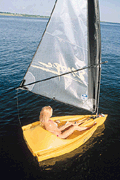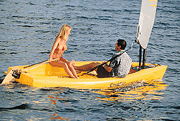Escape Cha Cha and Rumba
Daysailers
I started with the original Captiva model because I was looking for a sailing dinghy for my beach cabin. It replaced a well-used Bruynzeel plywood El Toro in which I taught my two sons to sail. The El Toro was not happy being hauled up over our rocky beach and had to be carried in and out of the water. The construction of the Escapes meant that I could slide the Captiva over the rocks with impunity.
My wife fell in love with the Captiva. She found that the color-matching Autosail system made sail trimming easy and she felt she could sail without any coaching from me. Soon she wanted her own Escape so we could "race." Another feature that makes the Escapes suitable for beginners is their stability. These little boats are as stiff as churches. There is a performance price to pay for this stability, but it's a worthwhile compromise when you sail in 49-degree water. Stability also plays a huge role in developing confidence quickly in a beginner. 
The Escape line now includes several new models. My new Escape is the bigger Rumba. I keep it near the office and use it to tour the marina. The roll-up mainsail system makes getting under way a snap and also allows for effortless reefing. I don't think the Rumba is as fast as a Laser but it's no toy either. The Rumba is big enough for two adults to sail comfortably. Your butt will get wet in waves but that's okay. The unique cockpit design of the Rumba lets you sit deep in the boat or on the rail for hiking. There is sufficient buoyancy in this hull to carry mom and pop and three small kids.
Rumba.gif (21468 bytes)For the ultimate in little-boat fun factor you should look at the new Cha Cha. This is a 55-pound, 7-foot, 6-inch dinghy with a forward rudder. You steer with a tiller that comes aft and this allows you to sit square in a bucket seat facing forward. The bucket seat is molded in. With the rudder forward and the tiller coming aft you push the tiller to the direction you want the boat to go. This can eliminate some of the confusion that occurs when beginners first take the helm.
There is no upkeep to these boats. I spray mine off with fresh water when I'm done just out of habit. The polyethylene hulls are extremely durable. They tend to be a little heavier than fiberglass hulls but the trade-off is worth it. I want dinghies that I can ignore for the winter.
There's nothing quite like teaching a kid to sail. My pal Andy came up to the cabin in his powerboat and asked if I could teach his 12-year-old daughter to sail. Here's my system. I put Lauren in the Captiva and waded into the water holding the Captiva on a beam reach. I had her sail straight out from the beach about 200 feet, then tack and sail straight back in (another beam reach) to where I stood waist deep in the water waiting to catch her. Then I turned her around and set her off again. After doing this several times I told her I wasn't going to catch her any more and she would need to tack again. In 10 minutes she was reaching back and forth with a big grin on her face. The grin on Andy's face was even bigger. I was glowing.
The Escape series are serious little fun boats perfect for spreading the joys of sailing.

Comments